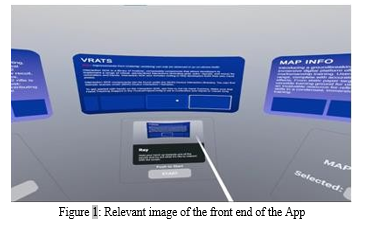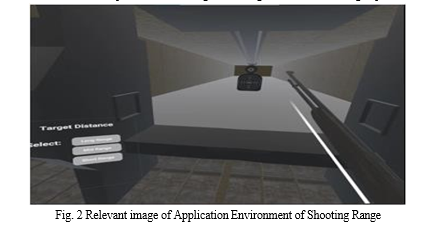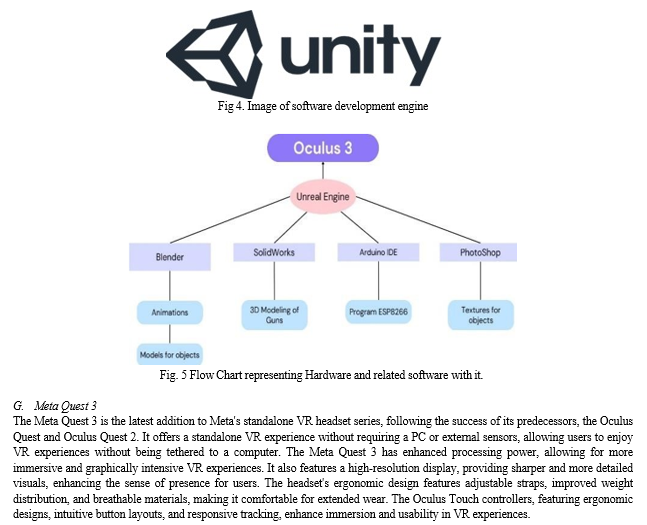Ijraset Journal For Research in Applied Science and Engineering Technology
- Home / Ijraset
- On This Page
- Abstract
- Introduction
- Conclusion
- References
- Copyright
Virtual Reality-Driven Army Training Simulator
Authors: Rachit Patil, Jayesh Fatnani, Sujay Kamuni, Aditya Shinde, Bindu Ramesh
DOI Link: https://doi.org/10.22214/ijraset.2024.59563
Certificate: View Certificate
Abstract
This study presents the VRATS system, a modern military training tool that uses advanced VR hardware and software to simulate various operational scenarios. VRATS offers AI-driven opponents, instantaneous performance feedback, and data analytics for skill enhancement. VRATS promotes decision-making, leadership, and adaptation, reducing injury risks, cutting costs, and improving training efficacy.
Introduction
I. INTRODUCTION
Cutting edge progress in the field of military readiness can be seen in the Virtual Reality-Driven Army Training Simulator (VRATS). VRATS is a revolutionary training environment that helps soldiers prepare for their missions by using the capabilities of immersive [1] Virtual Reality (VR) technology.
What is VRATS? It is an App that helps users have a realistic experience of a Shooting Range without having access to a real gun or any consequences related to it.
VRATS provides a multitude of advantages, such as data analytics for skill evaluation, realistic 3D settings, adaptive AI- driven opponents, and real-time performance feedback. These characteristics produce a comprehensive training program that improves soldiers' individual abilities while encouraging productive collaboration and leadership.
With the help of [2] VRATS, soldiers can train in a various of ways. Immerse them in realistic 3D worlds where they can complete mission-specific tasks, traverse a various of terrains, and react to a various difficult scenario. With the help of this virtual training environment’s adaptive AI-driven opponents, real-time performance feedback, and sophisticated data analytics, soldiers can improve their leadership qualities, decision-making skills, and general preparedness. Thus, VRATS maximizes training efficacy while minimizing the inherent hazards associated with traditional live workouts. The dedication of VRATS to ensuring uniform training across various military units and locations is one of its most notable attributes. The system benefits troops from different branches and places by providing a regulated and controlled environment that guarantees uniformity in training regimens. Ease of Use
II. LITERATURE REVIEW
The paper includes the creation of virtual reality (VR)-based military training programs, their effectiveness in enhancing troops' readiness and decision-making skills, and the role that VR principles play in training uniformity and standardization. Traditional military training programs face financial hardships, logistical challenges, and hazards to the safety of its people. Virtual reality technology offers a fresh substitute by providing flexible and immersive training environments that mimic real-world situations without the risks involved with live exercises.
Recent studies have demonstrated the effectiveness of several VR-based military training systems in improving troops' decision-making skills, skill development, and overall readiness. Important VR-based military training fundamentals include creating lifelike 3D environments, utilizing AI-driven opponents, providing real-time feedback, and utilizing data analytics.
The well-known game development engine Unity simplifies VR application development and improves VR application performance.
Virtual reality (VR)-based military training systems solve the difficulties of consistency and uniformity in training. They offer regulated, uniform training environments that ensure efficient instruction regardless of branch or location, enhancing overall efficacy and preparedness.
In conclusion, soldiers' preparedness, decision-making skills, and training consistency can all be considerably enhanced by virtual reality-based military training systems. These systems offer a cost-effective and adaptable solution to the evolving training needs of modern military forces by utilizing virtual reality technology and adhering to core principles. Research and development are needed if VR-based military training is to be even more successful and widely available.
III. PROPOSED METHODOLOGY
A. Needs Assessment
Conduct a thorough needs assessment by collaborating with military personnel and trainers to understand the specific training requirements, scenarios, and skills that VRATS should address.
B. System Design
Develop a detailed system design that includes the hardware and software components required for VRATS. Create realistic 3D environments, incorporate adaptive AI, and design user interfaces that facilitate interaction within the virtual world.
It consists of two things:
Lobby: The training environment for virtual reality (VR) has been significantly improved to increase user engagement and functionality. There are now three new canvases with project details, a map, a training range, and a display of a.22 rifle. By clicking buttons, users can alternate between the map canvas and the gun; instructions are provided in a tutorial video. When they're ready, hitting the start button allows users to instantly teleport onto the training range or map, providing a more engaging and intuitive experience.
The user interface is further improved by interactive elements that offer navigation options, firearm specifics, and important project information. By pressing buttons, users can interact with the canvases and quickly flip between different displays. Thanks to simple button controls, users can effortlessly move between various parts of the start scene with seamless transitions. To offer detailed guidance on utilizing the interactive elements, navigating between canvases, and teleporting to various areas inside the training environment, a tutorial movie has been integrated into the opening scene.
By just hitting the start button, users may effortlessly move from the opening scene to their preferred training setting thanks to the teleportation feature, which does away with the necessity for difficult menu navigation or manual movement. This makes it easier for users to join the training scenario, which frees them up to concentrate more on their goals and make the most of their time in the virtual reality environment.
The user experience in VR training settings is much improved with the addition of interactive elements, smooth transitions, tutorial movies, and teleportation functions.

C. Training Range
Creating a virtual reality (VR) training environment for practicing with weapons is a complex process that requires meticulous attention to detail. Key features include a 3D shooting range model, realistic shooting mechanics, adjustable target distance, and app deployment within VR headsets. The training range offers a visually engaging environment with target stands and safety procedures, allowing users to engage and control the firearm in a realistic manner. The realistic shooting mechanics imitate the actions of firing a real firearm, providing accurate simulation of every shot.
Adjusting the target distance allows users to practice shooting at varied ranges, improving their aim and preparing them for real-world settings. This adaptability gives the training environment more difficulty and variability. The VR training program can be easily integrated into VR headsets, allowing users to fully immerse themselves in the training experience.
Developing a VR training environment for practicing with weapons requires careful consideration of factors such as 3D modeling, shooting mechanics, target distance adjustment, and app deployment within VR headsets. This method allows users to improve their handgun competence and marksmanship in a secure setting, enhancing their overall training experience.

D. VR Hardware Acquisition and Setup
Invest in top-notch virtual reality (VR) headsets that work with the platform of your choice, such as Oculus Rift, HTC Vive, or Valve Index, to create an immersive training environment for practicing with weapons. Invest in motion tracking equipment to record users' motions and interactions in the virtual reality environment. Examples of such equipment include external sensors and inside-out cameras.
Create a 3D printed replica of a.22 rifle that closely resembles the size and characteristics of the original weapon, complete with a hole for the VR headset controller. To ensure stability and comfort, use a material that is both lightweight and robust while 3D printing. To guarantee precise tracking and response during training simulations, calibrate the VR hardware and motion tracking devices. To ensure correct operation and compatibility, test the 3D printed gun, VR controller slot, and overall configuration.
Install the motion tracking equipment, haptic feedback systems, and VR hardware in a dedicated training facility that allows enough room for mobility. Set up the virtual reality software to detect the 3D printed rifle model and process inputs from the built-in VR controller slot. Adjust the VR environment's settings and parameters to customize the training to user preferences and particular scenarios.

E. Software Development
A variety of tools and an easy-to-use interface are offered by Unity for the creation of interactive content. With Unity's visual editor, developers can design locations, add items, and create scenes. Because the engine supports C# scripting, developers can use it to create unique interactions and behaviors for their applications. To speed up development, projects can utilize the extensive collection of pre-made assets, scripts, and plugins available in Unity's Asset Store.
Using VR with Unity: Oculus Rift, HTC Vive, Windows Mixed Reality, and other VR systems are just a few of the platforms that Unity comes with built-in support for. With a few easy steps, developers can activate VR compatibility in Unity projects, enabling them to create engaging VR headset experiences.
Unity's XR Interaction Toolkit offers a range of tools and components, such as object interaction, user interface elements, and locomotion, that are specifically made for VR production.
Within the Unity editor, developers can design 3D settings that are ready for virtual reality, incorporate VR-specific interactions, and enhance performance for VR gear.
Unity's real-time rendering capabilities make VR experiences snappy and seamless, giving consumers a greater sense of presence and immersion Important Elements for VR Development: The physics engine in Unity makes it possible for virtual objects and environments to interact realistically, which improves the VR experience's sensation of presence.
VR storytelling can be improved by developers using the Timeline and Cinema chine tools to produce cinematic scenes and camera motions. With Unity's cross-platform support, developers can create VR apps that work across a variety of platforms and devices, appealing to a wider user base. To guarantee that customers have a seamless and enjoyable VR experience, creators can find and fix performance issues with the use of Unity's profiling and optimization tools.
F. Society and Assets
Through conversations, tutorials, and online communities, a thriving community of Unity developers, designers, and enthusiasts exchange information, tools, and support. To assist developers in learning advanced techniques and getting started with VR creation, Unity offers a wealth of tutorials, learning materials, and documentation.


IV. FUTURE SCOPE
The company is enhancing its virtual reality shooting app to improve the user experience and realism of firearms training simulations. The app will introduce new gun models with 2x and 4x scopes, enhancing aiming capabilities and allowing users to engage in long-range shooting scenarios. AI-based opponents will be integrated into the virtual environment, powered by sophisticated algorithms that simulate human-like behaviors and responses.
These opponents add depth and excitement to the shooting experience, requiring users to adapt their strategies and tactics to outmaneuver and outshoot their virtual adversaries. A gun recoil system will be implemented to mimic the physical feedback of firing a weapon, creating an immersive and sensory-rich environment.
The app also incorporates sophisticated data analytics capabilities, allowing users to track and analyze their performance metrics, providing valuable insights into their proficiency and areas for improvement. These enhancements aim to provide users with an immersive, challenging, and rewarding virtual shooting experience, pushing the boundaries of realism and interactivity in firearms training simulations.
Conclusion
In conclusion, A ground-breaking tool for military training, the Virtual Reality-Driven Army Training Simulator (VRATS) uses immersive virtual reality technology to improve soldier readiness and decision-making skills. It offers an economical, dynamic, and flexible solution while lowering the hazards connected with conventional live exercises. Realistic 3D environments, adaptive AI, real-time performance feedback, and data analytics are all part of the extensive process used in the creation and implementation of VRATS. VRATS has shown its potential to increase military preparedness, save training costs, and foster uniformity across many units and locations through pilot testing, large-scale deployment, and ongoing development. Not merely a training simulator, VRATS represents a revolutionary advance in military readiness and training quality, and it has a profound impact on the abilities and efficacy of the armed services.
References
[1] An integrated medical virtual reality program. The military application RM Satava, SB Jones IEEE engineering in medicine and biology magazine, 1996•ieeexplore.ieee.org [2] Enhancing combat medic training with 3D virtual environments R Brown, S McIlwain, B Willson, M Hackett 2016 IEEE International Conference on Serious Games and …, 2016•ieeexplore.ieee.org [3] Application of VR technology in simulated attack training of armed helicopters X Liu, X Yan, Z Ding, J Zhang 2022 IEEE Conference on Telecommunications, Optics and Computer …, 2022•ieeexplore.ieee.org [4] Mixed reality training for tank platoon leader communication skills P Khooshabeh, I Choromanski, C Neubauer, DM Krum, R Spicer, J Campbell 2017 IEEE Virtual Reality (VR), 2017•ieeexplore.ieee.org [5] https://www.gettyimages.in/detail/news-photo/technician-adjusts-the-trigger-on-an-m240-medium-machine-news- photo/455491992 [6] https://www.gettyimages.in/detail/news-photo/an-armed-police-force-oldier-wearing-a-virtual-reality-news-zhoto/1346691721
Copyright
Copyright © 2024 Rachit Patil, Jayesh Fatnani, Sujay Kamuni, Aditya Shinde, Bindu Ramesh. This is an open access article distributed under the Creative Commons Attribution License, which permits unrestricted use, distribution, and reproduction in any medium, provided the original work is properly cited.

Download Paper
Paper Id : IJRASET59563
Publish Date : 2024-03-29
ISSN : 2321-9653
Publisher Name : IJRASET
DOI Link : Click Here
 Submit Paper Online
Submit Paper Online

